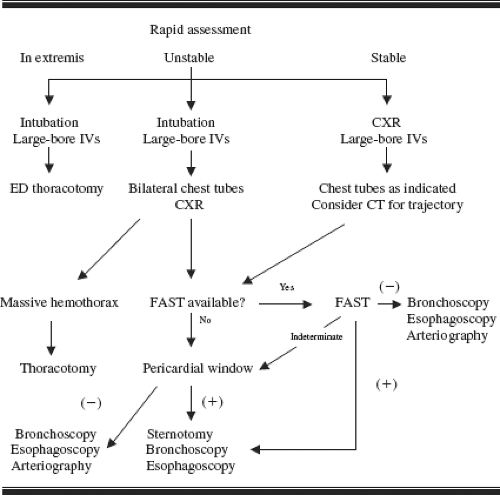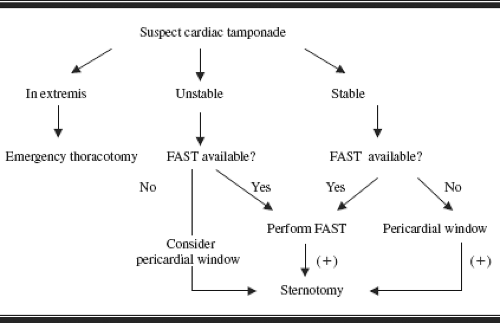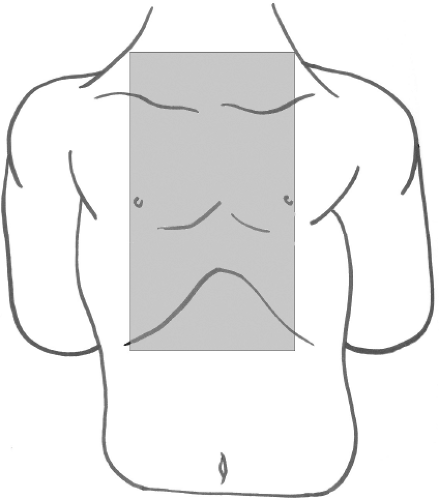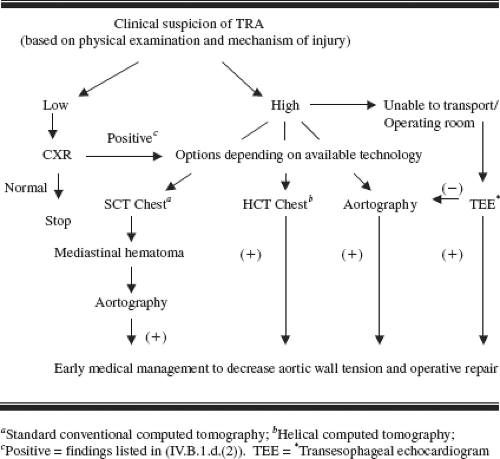Thoracic Injuries
Juan A. Asensio
Federico N. Mazzini
Thai Vu
I. Introduction
Thoracic injuries are responsible for approximately 25% of all trauma deaths and in addition contribute to 25% of deaths annually in the United States. Immediate deaths usually involve blunt disruption of the heart or great vessels or penetrating injuries to the thoracic vessels. Deaths within a few hours are frequently caused by airway obstruction, tension pneumothorax, hemorrhage, or cardiac tamponade. Pulmonary complications, sepsis, and missed injuries account for late mortality.
Although thoracic injuries are often life threatening, the majority of thoracic injuries are managed nonoperatively. Treatment options include analgesia, aggressive respiratory therapy, endotracheal intubation, and tube thoracostomy. Only 10% to 15% of patients with chest injury will require thoracotomy or sternotomy.
Hemodynamic instability from a chest wound indicates a major vascular or cardiac injury that mandates immediate control of hemorrhage. Ideally, emergency operations on the chest should be performed in the operating room (OR) after a brief resuscitation. However, cardiac tamponade or exsanguination will require definitive procedures in the trauma resuscitation area.
The chest cavity is more compartmentalized than the abdomen. The bony chest wall, clavicles, and shoulders make operative exposure of injured viscera difficult. Large, relatively fixed structures limit exposure of the posterior mediastinum. Thus, the choice of thoracic incision is determined by the expected anatomic injury, the urgency with which surgical access is required, and the patient’s hemodynamic stability.
II. Immediate Evaluation
Physical examination includes evaluation of upper airway, chest wall symmetry and stability, breath sounds, and heart sounds. Findings of decreased breath sounds, subcutaneous emphysema, jugular venous distension (JVD), and tracheal deviation are specifically sought early in the evaluation.
Begin resuscitation while performing concurrent diagnostic procedures. Administer oxygen by high flow, non-rebreathing mask. If the patient does not respond adequately to volume resuscitation as evidenced by persistent hypotension, tachycardia, or decreased mental status, consider ongoing blood loss, and re-assess for the presence of cardiac tamponade, tension pneumothorax, and cardiogenic shock from blunt cardiac injury (BCI).
When a major thoracic vascular injury is suspected, initiate prompt resuscitation while searching for the cause.
Perform immediate endotracheal intubation.
Place two large-bore intravenous (IV) lines for volume infusion, ideally one above and one below the diaphragm. Avoid central lines on the side of injury.
Infuse pre-warmed crystalloids. Consider transfusing warmed blood immediately, and other blood products as needed (see Chapter 7).
Have rapid-infusion and cell-saver devices immediately available.
Administer tetanus prophylaxis and preoperative antibiotics.
Monitor pulse oximetry and electrocardiogram (ECG) continuously.
Obtain a chest x-ray (CXR) early in the evaluation of all patients sustaining thoracic injury. Sites of missile entry or penetration should be identified with radiopaque markers (e.g., metallic markers, paper clips).
In patients with significant injury, an arterial blood gas (ABG) is useful to determine adequacy of ventilation and acid–base status.
Identify indications for immediate operation.
Massive hemothorax (1,000 to 1,500 mL blood returned on insertion of chest tube)
Ongoing hemorrhage from chest (>200 mL/h for ≥4 hours)
Presence of cardiac tamponade
Penetrating transmediastinal chest wounds with hemodynamic instability
Open thoracic injuries or impalement wounds to the chest
Massive air leak from the chest tube or major tracheobronchial injury identified on bronchoscopy
Mediastinal hematoma or radiographic evidence of great vessel injury with hemodynamic instability.
Suspected or confirmed air embolism
III. Immediate Management of Penetrating Thoracic Wounds
DO NOT PROBE the wound to determine depth or angle, which can produce pneumothorax or hemothorax.
Obtain a CXR with metallic markers placed on all penetrating wounds.
Attempt to determine trajectory to delineate anatomic injury.
Perform immediate tube thoracostomy for pneumothorax or hemothorax.
Administration of prophylactic antibiotics such as cefazolin or cefoxitin, as a single dose before the start of the procedure, has been recommended to decrease the risk of empyema and pneumonia.
If negative, repeat film in 6 hours; approximately 7% to 10% of this population will develop delayed pneumothorax.
Administer tetanus prophylaxis.
Routine antibiotics are not used for penetrating wounds treated without an operation or procedure.
IV. Immediate Evaluation of Transmediastinal Penetrating Wounds
Diagnosis of transmediastinal penetration is based on clinical suspicion, trajectory of the missile, or CXR findings. Rapidly assess airway, hemodynamic status, and need for hemorrhage control.
Classify the patient, based on hemodynamics, as in extremis, unstable, or stable (Fig. 28-2).

Figure 28-2. Diagnostic algorithm for transmediastinal penetrating trauma. FAST, focused abdominal sonography for trauma; CXR, chest x-ray; ED, emergency department; CT, computed tomography.
The patient in extremis has agonal respirations without measurable blood pressure.
Intubate, oxygenate, and start volume resuscitation.
Perform immediate left anterolateral resuscitation thoracotomy to control hemorrhage or relieve cardiac tamponade. If needed, extend across sternum to a right thoracotomy (“clamshell thoracotomy”).
Control bleeding from pleural cavities or heart injuries as necessary.
The unstable patient has a measurable blood pressure but is hypotensive, with a systolic blood pressure <90 mm Hg. These patients, with associated transmediastinal trajectory, often have injuries to the following organs (in descending frequency): Lung, heart, chest wall vessels, great vessels, esophagus, trachea or bronchi, and pulmonary artery or vein or their branches.
Assess the need for intubation, oxygenate, and start volume resuscitation.
Obtain a CXR.
Perform tube thoracostomy for pneumothorax or hemothorax.
Perform a focused abdominal sonography for trauma (FAST) ultrasound examination to diagnose pericardial effusion.
A positive pericardial view on the FAST in an unstable patient is an indication to proceed with immediate median sternotomy.
An equivocal pericardial view on the FAST examination necessitates either sub-xiphoid window or an exploratory median sternotomy.
A negative FAST can be falsely negative secondary to decompression of pericardial blood into the pleural space. Consider sub-xiphoid pericardial window if there is a suspicion of middle mediastinal trajectory.
If FAST is not available, proceed to the OR for sub-xiphoid pericardial window.
Thoracotomy is performed, as indicated, based on the output of chest tube and the hemodynamic status of the patient (see II.F.)
After major hemorrhage is controlled, perform flexible esophagoscopy and bronchoscopy to diagnose aerodigestive tract injury. A gastrografin swallow study can be used in lieu of esophagoscopy with about the same sensitivity (see V.B.5). The two tests in combination yield sensitivity >90%.
If great vessel injury is suspected by trajectory and the patient remains hemodynamically stable without any other operative indication, perform angiography to evaluate potential vascular injury.
In the stable patient, evaluate possible cardiac injury or great vessel injuries as well as injuries to the esophagus, trachea, and bronchi.
Assess the need for intubation, oxygenate, and start volume resuscitation.
Obtain a CXR.
Perform tube thoracostomy for pneumothorax or hemothorax.
If available, perform a FAST ultrasound examination to diagnose pericardial effusion (see IV.D.4).
A search for mediastinal injury can be guided by presenting signs and symptoms. A combination of the following tests may be needed to exclude injuries.
Computed Tomography of the chest (CCT), ideally CTA (CT angiography), can be used to determine trajectory and thus guide subsequent diagnostic procedures.
Esophagoscopy or esophagography for posterior mediastinal trajectories or in patients with hematemesis.
Bronchoscopy for patients with large air leaks after tube thoracostomy or those which present with hemoptysis.
Angiography for patients with mediastinal, thoracic inlet/zone I of the neck or axillary hematomas if CTA is not diagnostic.
Table 28-1 Major Thoracic Injury | ||||||||||||||||
|---|---|---|---|---|---|---|---|---|---|---|---|---|---|---|---|---|
|
V. Major Thoracic Injuries
Can be divided into those that are immediately life threatening and those more difficult to diagnose (Table 28-1).
Immediate life-threatening injuries
Airway obstruction. Control of the airway is foremost in trauma resuscitation. The airway must be secured quickly, with attention to the possibility of associated cervical spine injury.
Causes
Relaxation of the tongue into the posterior pharynx in the unconscious patient occludes the airway.
Loose dentures, avulsed teeth, lacerated tissue, secretions, or blood pooling in the mouth and hypopharynx.
Bilateral mandibular fractures allowing the tongue to collapse into the hypopharynx.
Expanding neck hematoma producing deviation of the larynx and mechanical compression of the trachea.
Laryngeal trauma (e.g., thyroid or cricoid cartilage fractures) producing submucosal hemorrhage and edema.
Tracheal tear or transection.
Physical findings include stridor, hoarseness, subcutaneous emphysema, altered mental status, accessory muscle use, air hunger, apnea, and cyanosis (sign of preterminal hypoxemia).
Any suspicion of airway obstruction or inability to exchange air adequately mandates early intubation.
Management (see Chapter 3).
When in doubt, intubate using a controlled rapid sequence intubation (RSI).
Provide in-line cervical spine immobilization during intubation.
Intubate early, especially in the presence of neck hematomas in either zone I or II or possible airway edema. Airway edema can be insidious and progressive and can make delayed intubation more difficult.
Must always have equipment for emergency cricothyroidotomy readily available if endotracheal intubation fails.
Rescue airway techniques such as the combitube or laryngeal mask airway (LMA) should be used only by personnel who have had formal training in the use of these devices.
These are not definitive airways, as defined as a cuffed tube traversing the vocal cords.
If patients arrive with these airways in place, they should only be exchanged by practitioners familiar with their design and use.
Tension pneumothorax occurs when air enters the pleural space from lung injury or through the chest wall without a means of exit. Pressure develops within the pleural space, compressing the superior and the inferior vena cava, impairing venous return and decreasing cardiac output (CO).
Most common causes
Penetrating injury to the thorax
Blunt trauma with parenchymal lung injury
Mechanical ventilation with high airway pressures
Spontaneous pneumothorax with blebs that fail to seal
Diagnosis
Clinical diagnosis
Severe respiratory distress
Hypotension
Unilateral absence of breath sounds
Hyperresonance to percussion over affected hemithorax
JVD (can be absent in hypovolemic patients)
Tracheal deviation (late finding—not necessary to confirm clinical diagnosis)
CXR will usually show a pneumothorax (PTX) large enough to cause tension, however, in a few cases a large anterior or posterior collapse will not be evident on plain film.
Bedside ultrasound is now being applied to the diagnosis of pneumothorax with good results.
Treatment
Immediately decompress the affected hemithoracic cavity by inserting a 12 or 14 gauge IV catheter into the second intercostal space in the midclavicular line or fifth intercostal space in the anterior axillary line. This converts the tension pneumothorax into a simple open pneumothorax.
Follow immediately with tube thoracostomy.
Pericardial tamponade is commonly the result of penetrating trauma, but can also be present with blunt chest trauma. The pericardial sac does not tolerate acute distension, approximately 75 to 100 mL of blood can produce tamponade physiology in the adult.
Diagnosis (Fig. 28-3)
If awake, these patients are extremely anxious and even combative; they are reluctant to lie flat, and will often state that they sense “impending doom,” and may appear “deathlike.”

Figure 28-3. Diagnostic algorithm for suspected cardiac tamponade. FAST, focused abdominal sonography for trauma.
Suspect the presence of tamponade in the patient with persistent hypotension, acidosis, or base deficit, despite adequate blood and fluid resuscitation, especially if ongoing blood loss is not evident.
Classic signs. JVD, hypotension, and muffled heart sounds (Beck’s triad) are present in only 10% to 30% of patients with confirmed tamponade. JVD may not be present secondary to hypovolemia. Pulsus
paradoxus is a decrease in systolic pressure of >10 mm Hg during inspiration and also suggests tamponade. Kussmaul’s sign is a hard and true sign of tamponade; inspiration in a spontaneously breathing patient results in an increase of the JVD. The classic signs of cardiac tamponade are uncommon—shock or ongoing hypotension without evident blood loss is the usual trigger to suggest this injury.
If a pulmonary artery catheter is present, right- and left-side heart pressures will equalize. Central venous pressure approaches the pulmonary wedge pressure, and both will be elevated.
If available, a FAST ultrasound examination should be performed to identify pericardial fluid.
A positive pericardial view on the FAST in an unstable patient is an indication to proceed immediately to median sternotomy or left anterolateral thoracotomy.
An equivocal pericardial view on the FAST examination or a positive examination in a stable patient necessitates a sub-xiphoid operative pericardial window.
A negative FAST with a cardiac injury can be falsely negative secondary to decompression of pericardial fluid into the pleural space.
Treatment. Generally, the multiple interventions mentioned below are instituted simultaneously. These can be performed in either the emergency department (ED) or the OR, based on the clinical condition of the patient.
Assess the need for intubation, oxygenate, and start volume resuscitation.
If a surgeon is not available, pericardiocentesis can be used only as a temporizing maneuver to relieve tamponade. This is often difficult to successfully perform because of the “blind” nature of the procedure and relatively small blood volume in the sac. Similarly, it cannot evaluate pericardial clot (see VII.C).
If the patient is in extremis, an emergent left anterolateral thoracotomy should be performed to open the pericardium, relieve the tamponade, and repair the underlying cardiac injury.
If the patient is unstable, emergency median sternotomy should be performed in the OR.
If the patient is stable, a diagnostic sub-xiphoid pericardial window can be performed in the OR to confirm the diagnosis. If this reveals blood in the sac, the incision is converted to a median sternotomy.
Open pneumothorax (sucking chest wound)
Usually caused by impalement injury or destructive penetrating wound (shotgun).
Large open defect in chest wall (>3 cm diameter) with equilibration between intrathoracic and atmospheric pressure.
If the opening is greater than two-thirds the diameter of the trachea, air follows the path of least resistance through the chest wall with each inspiration, leading to profound hypoventilation and hypoxia. Signs and symptoms are usually proportional to the size of the defect.
Management
Intubate, if patient is unstable or in any respiratory distress.
Temporarily close the chest wall defect with a sterile occlusive dressing taped on three sides to act as a flutter-type valve. Avoid securing the dressing on all four sides in the absence of a chest tube, as this can produce a tension pneumothorax.
Perform tube thoracostomy on the affected side. Avoid placing the tube near or through the traumatic wound.
Perform urgent thoracotomy to evacuate blood clot and treat associated intrathoracic injuries.
Irrigate, debride, and close the chest wall defect in the OR.
Large defects may require musculocutaneous flap closure, often in a delayed fashion.
Massive hemothorax
Common in penetrating trauma with hilar or systemic vessel disruption
Intercostal and internal mammary vessels are most commonly injured.
Each hemithorax can hold up to 3 L of blood.
Neck veins can be flat secondary to hypovolemia or distended because of the mechanical effects of intrathoracic blood.
Hilar or great vessel disruption will present with severe shock.
Diagnosis
Hemorrhagic shock
Unilateral absence or decreased of breath sounds
Unilateral dullness to percussion
Flat neck veins
CXR will show unilateral “white out” (opacification)
Treatment
Intubate patients in shock or with any respiratory difficulty.
Establish large-bore IV access (ideally a femoral line in this setting) and have blood available for transfusion before decompression.
If available, have an autotransfusion setup for the chest tube collection system.
Perform tube thoracostomy with a large chest tube (36F or 40F) in the fifth intercostal space, anterior to mid-axillary line.
A second chest tube may occasionally be necessary to adequately evacuate the hemothorax.
Thoracotomy is indicated for:
Hemodynamic decompensation or ongoing instability because of thoracic bleeding
1,000 to 1,500 mL blood evacuated initially
Ongoing bleeding of >200 mL/h for ≥4 hours
Failure to completely drain hemothorax, despite at least two functioning and appropriately positioned chest tubes
Consider early video-assisted thoracoscopy (VATS) for incompletely drained or clotted hemothorax.
Flail chest usually results from direct high energy impact. The flail segment classically involves anterior (costochondral cartilage) or lateral rib fractures. Posterior rib fractures usually do not produce a flail segment because the heavy musculature of the posterior chest wall provides stability.
Diagnosis
Diagnosis is made when two or more ribs are fractured in two or more locations, which may lead to paradoxical motion of that chest wall segment. Patients on positive pressure ventilation may not show this paradoxical motion.
Blunt force of injury typically produces an underlying pulmonary contusion. Morbidity and mortality are generally related to the pulmonary parenchymal injury rather than the chest wall injury.
The patient is at high risk for pneumothorax or hemothorax, either as an immediate or delayed presentation.
The flail segment, underlying pulmonary contusion, and splinting caused by pain all exacerbate hypoxemia.
Associated abdominal injuries occur in approximately 15% of patients with flail chest.
Management
Immediately intubate for shock or signs of respiratory distress, such as:
Labored breathing requiring use of accessory muscles of respiration
Respiratory rate >35/min or <8/min
Oxygen saturation <90%, PaO2 <60 mm Hg
PaCO2 >55 mm Hg
Consider intubation for patients with hemodynamic instability, need for other surgical interventions, chronic obstructive pulmonary disease (COPD), cardiac disease, or advanced age.
Admit the patient to the surgical intensive care unit (SICU). The natural progression of the injury is worsening hypoxemia and respiratory insufficiency.
Control pain (see Chapter 15).
Regional analgesia in the form of an epidural block is the most effective way to deliver pain relief for patients with chest wall trauma. Paravertebral catheters are also effective.
Systemic opioids by continuous infusion or patient-controlled anesthesia (PCA).
Intercostal nerve blocks.
Monitor pulse oximetry and, if available, monitor continuous end tidal CO2.
Provide aggressive pulmonary therapy, including incentive spirometry and cough-deep breathing. Adequate pain control and continuous positive airway pressure (CPAP) may preclude intubation. Promote removal of pulmonary secretions.
Commotio Cordis is sudden death after a blunt injury to the chest. The injury most often occurs during sporting events where a direct blow to the chest is caused by a fast moving ball, such as a baseball or lacrosse ball.
Patients will not necessarily have a structural injury such as BCI.
The most common dysrhythmia is ventricular fibrillation, possibly caused by massive activation of the Sodium–Potassium–ATP channels.
Treatment consists of following ACLS procedures and aggressive cardiopulmonary resuscitation. Despite prompt and skillful resuscitation, some patients will not be able to be resuscitated.
Potentially life-threatening injuries
Traumatic rupture of the aorta is defined as a tear in the wall of the aorta that is contained by the adventitia of this artery and the parietal pleura.
The mechanism of injury is rapid deceleration, such as falls from significant heights, high-speed motor vehicular collisions, or ejection. Thoracic aortic injury may also occur with significant lateral impacts, especially in older patients. Approximately, 80% of these patients die at the scene. The remaining patients are at risk for delayed free rupture into the mediastinum or pleural space.
Patients may be asymptomatic or complain of chest pain. Survivors have contained ruptures. Since free rupture of the transected aorta is rapidly fatal, persistent or recurring hypotension usually results from secondary hemorrhage from other source and not the aortic injury.
Laceration is usually located near the ligamentum arteriosum (85%). Less often, injury is situated in the ascending aorta, at the diaphragm, or in the mid descending thoracic aorta.
Diagnosis (Fig. 28-4)
Clinical signs
Asymmetry in upper extremity blood pressures and upper extremity hypertension
Widened pulse pressure
Chest wall contusion
Posterior scapular pain, interscapular murmur
One-half of patients with great vessel injury from blunt trauma have no external signs of blunt chest injury.
Stay updated, free articles. Join our Telegram channel

Full access? Get Clinical Tree








